
The Royal Concertgebouw is a concert hall in Amsterdam, Netherlands. The Dutch term "concertgebouw" translates into English as "concert building". Its superb acoustics place it among the finest concert halls in the world, along with Boston's Symphony Hall and the Musikverein in Vienna.

The Wiener Musikverein, commonly shortened to Musikverein, is a concert hall in Vienna, Austria, which is located in the Innere Stadt district. The building opened in 1870 and is the home of the Vienna Philharmonic orchestra.

Seiji Ozawa was a Japanese conductor known internationally for his work as music director of the Toronto Symphony Orchestra, the San Francisco Symphony, and especially the Boston Symphony Orchestra (BSO), where he served from 1973 for 29 years. After conducting the Vienna New Year's Concert in 2002, he was director of the Vienna State Opera until 2010. In Japan, he founded the Saito Kinen Orchestra in 1984, their festival in 1992, and the Tokyo Opera Nomori in 2005.

Symphony Hall is a 2,262 seat concert venue in Birmingham, England. It was officially opened by Queen Elizabeth II on 12 June 1991, although it had been in use since 15 April 1991. It is home to the City of Birmingham Symphony Orchestra and hosts around 270 events a year. It was completed at a cost of £30 million. The hall's interior is modelled on the Musikverein in Vienna and the Concertgebouw in Amsterdam. The venue, managed alongside Town Hall, presents a programme of jazz, world, folk, rock, pop and classical concerts, organ recitals, spoken word, dance, comedy, educational and community performances, and is also used for conferences and business events as part of the International Convention Centre.

The Walt Disney Concert Hall at 111 South Grand Avenue in downtown Los Angeles, California, is the fourth hall of the Los Angeles Music Center and was designed by Frank Gehry. It was opened on October 23, 2003. Bounded by Hope Street, Grand Avenue, and 1st and 2nd Streets, it seats 2,265 people and serves, among other purposes, as the home of the Los Angeles Philharmonic orchestra and the Los Angeles Master Chorale. The hall is a compromise between a vineyard-style seating configuration, like the Berliner Philharmonie by Hans Scharoun, and a classical shoebox design like the Vienna Musikverein or the Boston Symphony Hall.
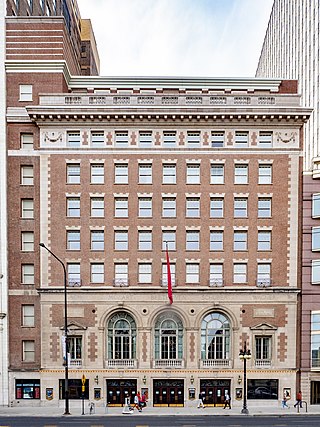
Symphony Center is a music complex located at 220 South Michigan Avenue in the Loop area of Chicago, Illinois. Home to the Chicago Symphony Orchestra (CSO); Chicago Symphony Chorus; Civic Orchestra of Chicago; and the Institute for Learning, Access, and Training; Symphony Center includes the 2,522-seat Orchestra Hall, which dates from 1904; Buntrock Hall, a rehearsal and performance space named for the CSO trustee and benefactor Dean L. Buntrock; Grainger Ballroom, an event space overlooking Michigan Avenue and the Art Institute of Chicago; a public multi-story rotunda; Forte, a restaurant and café; and administrative offices. In June 1993, plans to significantly renovate and expand Orchestra Hall were approved and the $110 million project resulting in Symphony Center, completed in 1997.

The Royal Festival Hall is a 2,700-seat concert, dance and talks venue within Southbank Centre in London, England. It is situated on the South Bank of the River Thames, not far from Hungerford Bridge, in the London Borough of Lambeth. It is a Grade I listed building, the first post-war building to become so protected. The London Philharmonic Orchestra, the Philharmonia Orchestra, the Orchestra of the Age of Enlightenment, the London Sinfonietta, Chineke! and Aurora are resident orchestras at Southbank Centre.

Orchestra Hall is a concert hall that is located on 11th Street at Peavey Plaza in downtown Minneapolis, Minnesota. The home of the Minnesota Orchestra, it is a major landmark of the southern portion of Nicollet Mall and hosts many events throughout the year, in addition to being the Orchestra's home.

Louise M. Davies Symphony Hall is the concert hall component of the San Francisco War Memorial and Performing Arts Center in San Francisco, California. The 2,743-seat hall was completed in 1980 at a cost of US$28 million to give the San Francisco Symphony a permanent home.

The Morton H. Meyerson Symphony Center is a concert hall located in the Arts District of downtown Dallas, Texas (USA). Ranked one of the world's greatest orchestra halls, it was designed by architect I. M. Pei and acoustician Russell Johnson's Artec Consultants, Inc. The structural engineers for this project was Leslie E. Robertson Associates, and opened in September 1989.

Tanglewood is a music venue and festival in the towns of Lenox and Stockbridge in the Berkshire Hills of western Massachusetts. It has been the summer home of the Boston Symphony Orchestra since 1937. Tanglewood is also home to three music schools: the Tanglewood Music Center, Tanglewood Learning Center, and the Boston University Tanglewood Institute. Besides classical music, Tanglewood hosts the Festival of Contemporary Music, jazz and popular artists, concerts, and frequent appearances by James Taylor, John Williams, and the Boston Pops.
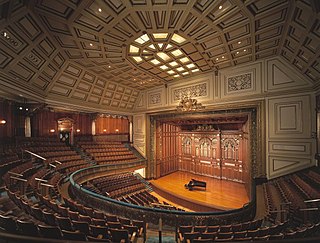
Jordan Hall is a 1,051-seat concert hall in Boston, Massachusetts, the principal performance space of the New England Conservatory. It is one block from Boston's Symphony Hall. It is the only conservatory building in the United States to be designated a National Historic Landmark. This building is currently under study by the Boston Landmarks Commission for landmark status.

The Suntory Hall (サントリーホール) is a concert venue in the central Akasaka district of Tokyo, Japan. Part of the Ark Hills complex, it consists of a main concert hall, widely considered one of the finest in the world for its acoustics — indeed Herbert von Karajan called it “a jewel box of sound” — and a smaller side-hall for chamber music. Its roof is an extended, tiered, landscape garden. Construction began in the late 1970s and the facility opened in October 1986.
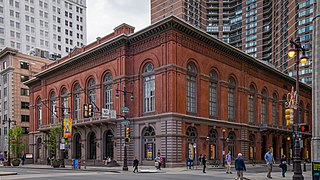
The Academy of Music, also known as American Academy of Music, is a concert hall and opera house located at 240 S. Broad Street in Philadelphia, Pennsylvania. Despite its name, the Academy has never contained a music school. It is located between Locust and Manning Streets in the Avenue of the Arts area of Center City.

Leo Leroy Beranek was an American acoustics expert, former MIT professor, and a founder and former president of Bolt, Beranek and Newman. He authored Acoustics, considered a classic textbook in this field, and its updated and extended version published in 2012 under the title Acoustics: Sound Fields and Transducers. He was also an expert in the design and evaluation of concert halls and opera houses, and authored the classic textbook Music, Acoustics, and Architecture, revised and extended in 2004 under the title Concert Halls and Opera Houses: Music, Acoustics, and Architecture.
The Jacksonville Symphony is an orchestra based in Jacksonville, Florida.
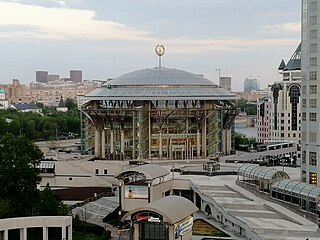
The Moscow International Performing Arts Centre was officially opened on September 28, 2003 with the debut of a new orchestra, the National Philharmonic of Russia under musical director Vladimir Spivakov. Also known as the Moscow International House of Music, it is situated on the Kosmodamianskaya Embankment off the Garden Ring Road.

Gewandhaus is a concert hall in Leipzig, the home of the Leipzig Gewandhaus Orchestra. Today's hall is the third to bear this name; like the second, it is noted for its fine acoustics.
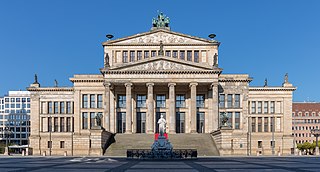
The Konzerthaus Berlin is a concert hall in Berlin, the home of the Konzerthausorchester Berlin. Situated on the Gendarmenmarkt square in the central Mitte district of the city, it was originally built as a theater. It initially operated from 1818 to 1821 under the name of the Schauspielhaus Berlin, then as the Theater am Gendarmenmarkt and Komödie. It became a concert hall after the Second World War, and its name changed to its present one in 1994.
The vineyard style is a design of a concert hall where the seating surrounds the stage, rising up in serried rows in the manner of the sloping terraces of a vineyard. It may be contrasted with the shoebox style, which has a rectangular auditorium and a stage at one end. Other possibilities are the fan-shaped and the arena. The design might be considered a musical theatre in the round.























